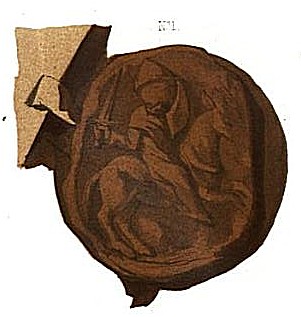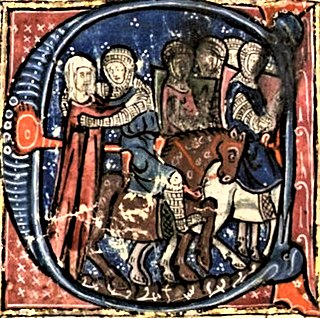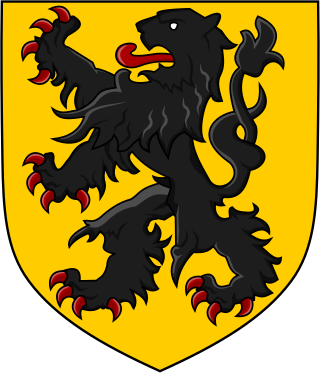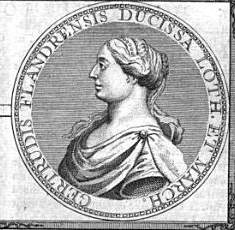
Eustace II,, also known as Eustace aux Grenons, was Count of Boulogne from 1049 to 1087. He fought on the Norman side at the Battle of Hastings, and afterwards received large grants of land forming an honour in England. He is one of the few proven companions of William the Conqueror. It has been suggested that Eustace was the patron of the Bayeux Tapestry.

Eustace III was the count of Boulogne from 1087 succeeding his father, Eustace II. He joined the First Crusade, being present at Nicaea, Dorylaeum, Antioch, and Jerusalem. After fighting in the battle of Ascalon, he returned home. Initially offered the Kingdom of Jerusalem, Eustace was at Apulia when he received news of Baldwin of Bourcq's election to the throne. On his return to Boulogne, he founded a Cluniac monastery in Rumilly, retired as a monk, and died in 1125.
Eustace I, Count of Boulogne, was a nobleman and founder of the Boulogne branch of the House of Flanders. He held the county of Boulogne from 1024 until his death in 1047.

The Counts of Louvain were a branch of the Lotharingian House of Reginar which from the late 10th century ruled over the estates of Louvain (French) or Leuven (Dutch) in Lower Lorraine.

Charles was the duke of Lower Lorraine from 977 until his death.
Albert I the son of Robert I, was a count who held the castle of Namur and a county in the Lommegau. His county came to be referred to as the County of Namur in records during his lifetime.

Godfrey III, called the Bearded, was the eldest son of Gothelo I, Duke of Upper and Lower Lorraine.
Gerberga or Gerberge was the name of several queens and noblewomen among the Franks.

Gothelo, called the Great, was the duke of Lower Lorraine from 1023 and of Upper Lorraine from 1033. He was also the margrave of Antwerp from 1005 and count of Verdun. Gothelo was the youngest son of Godfrey I, Count of Verdun, and Matilda, daughter of Herman, Duke of Saxony. On his father's death, he received the march of Antwerp and became a vassal of his brother, Godfrey II, who became duke of Lower Lorraine in 1012. Gothelo succeeded his brother in 1023 with the support of the Emperor Henry II, but was opposed until Conrad II forced the rebels to submit in 1025. When the House of Bar, which ruled in Upper Lorraine, became extinct in 1033, with the death of his cousin Frederick II, Conrad made Gothelo duke of both duchies, so that he could assist in the defence of the territory against Odo II, count of Blois, Meaux, Chartres and Troyes. It was during this time 1033-1034, that Gothelo clashed with Baldwin IV, Count of Flanders, concerning the march of Ename.
Adalbert I of Vermandois, was the son of Herbert II of Vermandois and Adela of France. Born about 915, he succeeded his father as Count of Vermandois in 946.
Frederick of Luxembourg was a younger son of Frederick, Lord of Gleiberg.
Count Lambert "the Bearded" was the first person to be described as a count of Leuven in a surviving contemporary record, being described this way relatively late in life, in 1003. He is also the patrilineal ancestor of all the future counts of Leuven and dukes of Brabant until his descendant John III, Duke of Brabant, who died in 1355.

Lambert II was count of Leuven between 1033 and 1054. Lambert was the son of Lambert I of Louvain and Gerberga, daughter of Charles, Duke of Lower Lorraine.

Ida of Lorraine was a saint and noblewoman.

Baldwin II of Boulogne was a son of Arnulf III, Count of Boulogne, whom he succeeded as count of Boulogne.
Henry I was the Count of Louvain from 1015 until 1038. He was a member of the House of Reginar.
Henry II was the Count of Louvain (Leuven) from 1054 through 1071 (?). Henry II was the son of Lambert II, Count of Louvain and Oda of Verdun. His maternal uncles included Pope Stephen IX and Duke Godfrey the Bearded of Lorraine.

The House of Flanders, also called the Baldwins, was a medieval ruling family of Frankish origin that was founded by Baldwin Iron Arm, son-in-law of Charles the Bald. The House of Flanders was the first dynasty to transform a county function of the Carolingian Empire into a hereditary fiefdom, the County of Flanders, falling under West Francia, created by the Treaty of Verdun in 843.

Gertrude of Flanders, was a Countess of Louvain and Landgravine of Brabant by marriage to Henry III, Count of Leuven, and a Duchess of Lorraine by marriage to Theodoric II, Duke of Lorraine. At the time the duchy was the upper Lorraine, since 959 separated from the duchy of Lower Lorraine.
Gerberga, Otto-William's mother, was, by her successive marriages, queen of Italy, margravine of Ivrea (965–970), and duchess of Burgundy (971/5–986/91).











